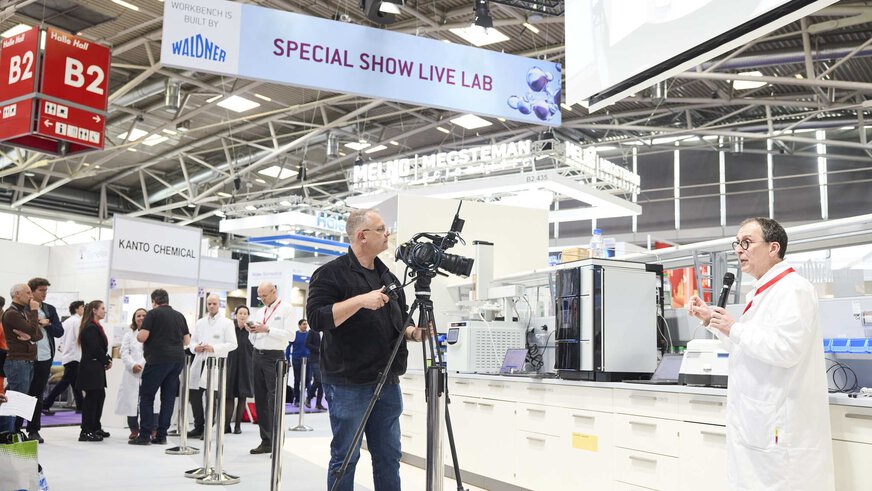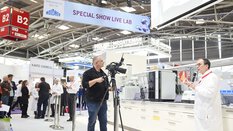Program special shows & events 2024

Program special shows & events 2024

Speakers special shows & events 2024

What does a state-of-the-art laboratory look like today and what equipment is being used? If you want to get an idea of this, you shouldn't miss the one-hour live demonstrations on the laboratory line.
Visitors will be able to gain practical insights and experience all common procedures or specific methods in a real laboratory environment. In the Live Lab in Hall B2 (B2.528), the work steps from sample preparation and sample measurement to analysis and evaluation of the results will be demonstrated.
There will also be time & space for questions: Discuss with the experts and exchange ideas: Whether on a current use case from your research laboratory or an issue from the development laboratory.
A show on the topic of digital transformation is set up next to the Live Lab. Presentations will also take place here three times a day, alternating with the Live Lab.
The company C3 demonstrates sample preparation for residue analysis using the QuEChERS method with two different devices in successive steps. The sample must be well ground and homogenized before extraction. For challenging matrices, it is advisable to grind the samples cold. In a two-stage process, a sample quantity of up to 1 kg is first cryogenically homegenized and then further processed in a for analysis.
It is not only the sophisticated process steps and modern analysis methods that determine the quality and accuracy of the analysis.
Consumables, whether reagents or classic laboratory materials such as gloves, vessels or sample tubes, can also have a major influence on the analysis. Carl Roth demonstrates the correct handling of different consumables.
With the ZEISS Axiovert 5 digital, Carl Zeiss demonstrates how artificial intelligence facilitates daily work in the cell laboratory. With this microscope, processes can be carried out more efficiently and results can be better reproduced. This ensures a relaxed working environment even in a busy laboratory.
Metrohm presents a robotic system for the fully automated analysis of oil samples using the example of TAN/TBN analysis. To ensure the highest possible throughput, a Universal Robot for automatic sample preparation operates in the system in parallel with a Sample Robot that performs various oil analyses with two workstations. During the demonstration, an overview of the system’s capabilities will be given.
Metrohm presents an OMNIS Titrator with optical sensor using the example of the determination of water hardness, which is described in various standards by manual titration with visual endpoint determination. This subjective technique is prone to human error and leads to less accurate and less reproducible results. The new ASTM D8192 standard describes how water hardness can be determined quickly and easily using an optical sensor for objective endpoint detection with a titrator.
In the modern food laboratory, innovative analytical methods play a decisive role in ensuring the quality and safety of products. One example of this is the analysis of edible oils, especially olive oil, which is popular worldwide due to its health benefits and unique taste. In the Live Lab, Thermo Fisher Scientific will demonstrate a variety of techniques and systems that are essential for the analysis of edible oils.
Chromatography is a key technique used to analyze the composition of olive oil. For example, gas chromatography (GC) and high-performance liquid chromatography (HPLC) can be used. Another important aspect of the analysis includes spectroscopic methods such as inductively coupled plasma emission spectroscopy (ICP), Raman spectroscopy and UV-Vis spectroscopy. In addition, rheological measurements are shown to determine the viscosity and flow properties of olive oil. Microbiological measurements also play a crucial role in our laboratory. Using an imaging flow cytometer, microorganisms in food samples can be counted and identified to ensure the safety and shelf life of food products.
Finally, the possibilities of a laboratory management system (LIMS) in the food laboratory are shown. A LIMS facilitates the organization of samples, the management of data and the traceability of analysis results, which leads to more efficient working methods and improved quality assurance.
Waldner presents a laboratory monitoring system. This clearly displays information about the laboratory infrastructure (fume cupboards, safety cabinets) and laboratory equipment. These information lead to a significant increase in safety for employees thanks to the quick check of the functional status of the individual systems.
Complementary technologies converging with others led to an extremely sustainable new 2LabsToGo analysis system. Technologies from the four different disciplines of chemistry (chromatographic separation), biology (biological effect detection), engineering (open-source technologies, 3D printing) and sustainability (dematerialization) merged in the unique miniaturized open-source system. The portable 2LabsToGo consolidated not only two fully equipped laboratories but also combines complementary technologies in the same analysis at low cost, which explains its strength.
At the Niederrhein University of Applied Sciences / Instrumental Analysis / Working Group Prof. Dr. Jürgen Schram, a new sustainable integral method for the analysis of micro-plastic particles in environmental environmental compartments and on (food) plant surfaces was developed.
μ-Sep is a previously published proprietary development for the enrichment-based separation of micro-plastic from sediments or (glass bead) sands.















